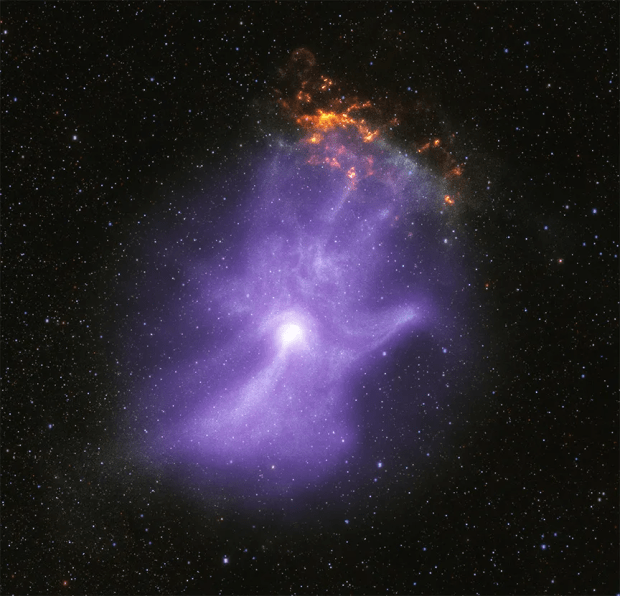
Two of NASA’s orbiting X-ray observatories have combined efforts this Halloween, imaging a ghost hand reaching out to us from space.
But all is not as it appears. This skeletal hand is actually the glowing gas of a pulsar wind nebula. This nebula, energized by the super-hot, super-magnetic remnant of a star that exploded some 1,500 years ago. And it’s the spooky subject of a combined effort between NASA’s Chandra X-ray Observatory and Imaging X-ray Polarimetry Explorer (IXPE).
A ghostly remnant
Located some 16,000 light-years away, this is pulsar PSR B1509-58 and its associated wind nebula, cataloged separately as MSH 15-52. When a massive star dies in a supernova explosion, it can leave behind a neutron star: a city-sized, rapidly rotating ball of neutrons with a powerful magnetic field. As the star, called a pulsar, rotates, it shoots out beams of both matter and antimatter from its poles, like a cosmic particle accelerator. These beams sweep through the gas left behind from the explosion, lighting it up as a pulsar wind nebula.
In this case, the pulsar itself is located at the very base of the palm, where the wrist would attach, while the ghostly hand that stretches to the upper right is the nebula.
Measuring magnetic fields
IXPE is a unique instrument designed to help astronomers untangle the workings of magnetic fields. The telescope observes the polarization, or orientation, of magnetic fields, which can reveal how magnetic fields are interacting with the material around them.
In this case, highly polarized magnetic fields stream away from the neutron star to the upper right, creating the “bones” of the hand as particles stream away from the pulsar and glow in X-rays. A high level of polarization means the magnetic field lines are oriented straight in space — a sign that there is very little turbulence in the region, which can cause a magnetic field to become twisted and tangled.
The same is not true at the base of the ‘ghost hand’ — there, the jet from the pulsar shows low polarization near the neutron star, then the magnetic field seems to straighten out farther from the star (to the lower left). Astronomers take this to mean the region near the pulsar is quite turbulent as it spews out energetic particles, then grows calmer and more ordered farther away.
“The IXPE data gives us the first map of the magnetic field in the ‘hand’,” said study leader Roger Romani of Stanford University in a press release. “The charged particles producing the X-rays travel along the magnetic field, determining the basic shape of the nebula, like the bones do in a person’s hand.”
This is not the first pulsar wind nebula IXPE has observed, though it is currently the record-holder for the object with the longest dedicated observation (17 days). IXPE has also peeked at the magnetic fields of the Crab Pulsar and the Vela Pulsar, two particularly famous pulsars, and seen similar behavior. This might indicate that pulsar wind nebulae, though they tend to look vastly different, all behave much the same way.
